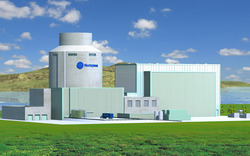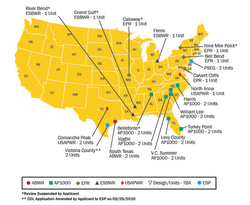Nuclear watchdog calls for probe into whistleblower charges over new reactor design
 A nuclear watchdog group in North Carolina received two letters this year from an anonymous whistleblower warning of problems with the design and regulatory approval process for the Westinghouse AP1000, a new type of reactor that utilities are planning to build across the Southeast.
A nuclear watchdog group in North Carolina received two letters this year from an anonymous whistleblower warning of problems with the design and regulatory approval process for the Westinghouse AP1000, a new type of reactor that utilities are planning to build across the Southeast.After receiving the letters, which contained details indicating the whistleblower has inside knowledge of the Nuclear Regulatory Commission, NC WARN forwarded them to NRC Chair Gregory Jaczko and NRC Inspector General Hubert Bell, both of whom the whistleblower also contacted directly. But neither Jaczko nor Bell have confirmed the letters' receipt -- or said whether they're investigating the charges.
So NC WARN made the letters public, posting them to their website here and here.
"It is evident that the person has inside knowledge of NRC-industry machinations and has taken personal risk to air the concerns, and the allegations coincide with thorny design problems made public in recent months," said NC WARN Executive Director Jim Warren.
Among the charges made in the letters:
* Anticipating monetary rewards and promotions, NRC officials rigged the AP1000 design approval process to confuse Congress and the NRC's own science advisors, thereby speeding it up in response to industry pressure.
* Design shortcomings were pushed through the approval process without full review or while ignoring industry standards. Those shortcomings involve passive emergency cooling, the reactor's shield building, and the radiation containment structure.
* The AP1000 (in Westinghouse illustration above) would not withstand an airplane strike similar to the attack against the World Trade Center on Sept. 11, 2001 "because scenarios that will bring down the shield wall and the containment all together have not been considered and not analyzed using computer codes that have been validated by our own US test data," the whistleblower wrote.
Warren believes NC WARN received the whistleblower's letters because the group's attorney, John Runkle, is involved in the AP1000 Oversight Group, which has raised numerous concerns about the reactor's design and filed a legal challenge against its fast-track approval process in April.
"It is now up to the public and responsible media to raise the issue and save our environment from gulf oil spill type of disaster that is in the making," the whistleblower wrote in a January letter sent to Runkle, nuclear engineer and outspoken AP1000 critic Arnie Gundersen, the New York Times and the Washington Post.
 Japanese meltdown amplifies concerns
Japanese meltdown amplifies concernsJust three days before NC WARN released the letters, the NRC announced that additional review of the AP1000 design turned up problems with Westinghouse's calculations for its concrete shield building, which is supposed to protect the reactor from external disasters such as earthquakes, hurricanes, tornadoes and airplane collisions. The shield building in the AP1000 also supports a storage tank for cooling water.
Jaczko told the New York Times that Westinghouse had failed to use a range of possible temperatures for calculating potential seismic stresses on the shield building in the event of an earthquake. He also said the NRC was asking Westinghouse not only to fix its calculations but to explain why it submitted faulty information in the first place.
The NRC first approved and certified the AP1000 design in 2006 but later raised concerns about the shield's adequacy. In May 2010, Westinghouse submitted a revised shield design, one of 19 revisions the company has made so far during the approval process.
"The fact that the Nuclear Regulatory Commission, which often operates as an industry lap dog, is voicing concerns is a sign of just how serious these design flaws are," said Tom Clements, a nuclear campaigner with Friends of the Earth in South Carolina.
Back in April, Clements' group was among those that called for the AP1000 licensing review to be halted and the public comment period extended, noting that the still-unfolding nuclear disaster in Japan has "amplified a host of concerns."
The NRC's lead structural engineer charged with evaluating the AP1000 reactor's shield building filed a formal statement against approving the design last November, citing concerns that the concrete being used is so brittle it could shatter. Other critics have pointed to issues with high storage density in the reactor's spent fuel pool and a weak radiation containment structure.
Westinghouse says it's confident in the AP1000 design and believes NRC's recent statements about the design issues are "being misinterpreted and sensationalized."
The Southern Company has already broken ground for two AP1000 reactors at its Plant Vogtle near Augusta, Ga. It's building the reactors with the help of $8.3 billion in taxpayer-backed federal loan guarantees that are contingent on the design's final approval.
U.S. utilities are planning to build a total of 14 new AP1000 reactors, all of them located in Southern states. Besides Georgia, those states are North Carolina, South Carolina, Florida and Alabama (see NRC map of planned reactors above; click on image for a larger version).
Tags
Sue Sturgis
Sue is the former editorial director of Facing South and the Institute for Southern Studies.
